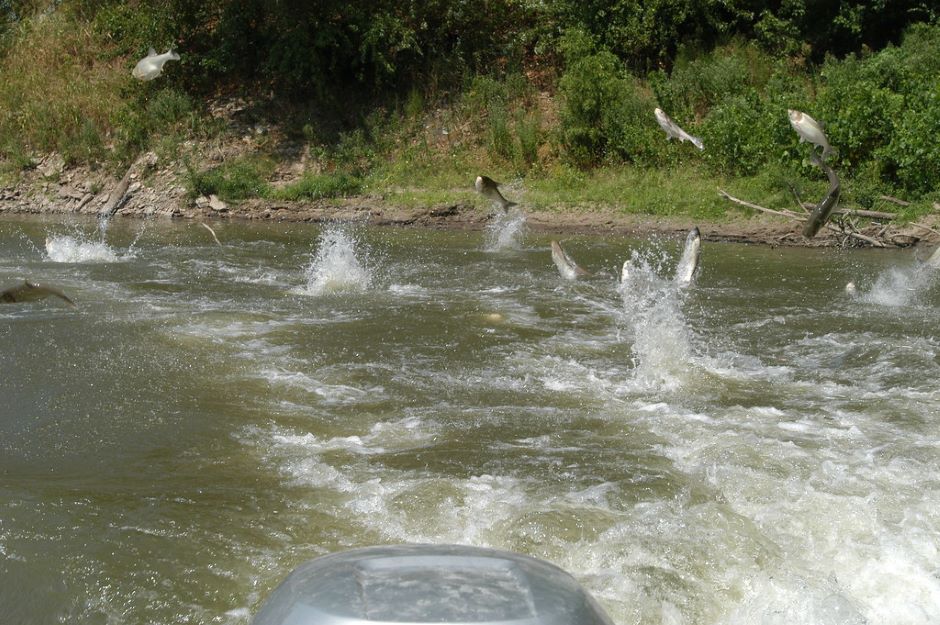Stopping the Spread of Asian Carp
 School of Jumping Silver Carp (Credit: Asian Carp Regional Coordinating Committee via CC BY-NC 2.0
School of Jumping Silver Carp (Credit: Asian Carp Regional Coordinating Committee via CC BY-NC 2.0When examining a natural ecosystem, bigger doesn’t always mean better. Unfortunately, when the species list expands due to invasive species, native populations can be pushed out as they’re out-competed and fall prey to intruders.
Asian carp is a colloquial term for a group of invasive carp in the United States. The National Park Service explains that bighead carp, black carp, grass carp, and silver carp are all collectively known as “Asian carp.” Carp are native to Europe and Asia but were brought to the U.S. in the late 1970s as an environmental management strategy.
Why Asian Carp Were Brought to the United States
While common carp have been in the U.S. for more than the last century, four species of carp have started to create trouble in the Mississippi River. The NPS shares that Asian carp were introduced originally in the 1970s as a means of controlling algae, weed and parasite growth in aquatic farms, weeds in canal systems and as a form of sewage treatment–it was only a matter of time before the fish invaded other waterways.
Indeed, the fish eventually escaped into the Mississippi River basin and began breeding. Over the years, Asian carp have slowly moved upward through the river and its tributaries. The NPS reports that invasive carp have been found as far north as Minnesota.
They’ve been able to spread in the U.S. successfully because they can easily hop barriers that would typically impede other species, and human actions have enabled the spread. The NPS reports, “The release of live bait containing young carp has introduced these fish to other water bodies. Barge and recreational watercraft moving through Mississippi River locks may also permit invasive carp to move through as well.”
How Asian Carp Affect the Ecosystem
Asian Carp can grow to be massive in comparison to many other freshwater species. In order to develop and maintain their impressive size, Asian carp have an overlapping diet with other large species and devour disproportionate amounts of smaller species. Less aggressive and smaller species are out-competed by the carp, evident in the decrease in size and weight that native species have undergone since the invasion.
The NPS also reports that Asian carp are generally assumed to lower water quality, harming filter feeders like mussels. Silver carp, one of the types of carp categorized as Asian carp, are known to jump out of the water when they feel threatened. According to the Minnesota DNR, silver carp can weigh up to 90 lbs. on average—meaning that when they leap out of the water, they can do actual harm to the environment and cause financial damage to anglers.
They may jump onto boats causing them to flip or damage boating equipment. The fish may also harm anglers as they exit the water, but even without the physical damage, Asian carp threaten the fishing industry. As they move further up the Mississippi River, they may endanger native and popularly caught fish.
Asian Carp Diet
Some Asian carp have been known to weigh in at as much as 110 lbs., but their diets are actually composed of smaller organisms. However, the quantity in which they consume these organisms leaves little for native species to feed on.
Bighead and silver carp eat plankton, much like native mussels and fish populations rely on. Other species like the grass carp consume plants at a rate that “can drastically change river and shoreline vegetation and spawning and cover for native fish,” according to the NPS. Black carp eat snails and mussels, including endangered species which may lead to further population instability.
Conclusion
In order to stop the spread of Asian carp, it is important that anglers play a role in helping to monitor this invasive species. Additionally, taking steps to minimize the potential introduction of invasive carp to uninvaded areas is important.
Avoiding barges along the Mississippi will also help keep carp from passing through these entrances alongside boats. Additionally, ensuring that carp are not used as live bait can prevent the species from settling in a new environment.



Pingback: FishSens Magazine | Invasive Starry Stonewort Shaping Ecosystems - FishSens Magazine
Pingback: FishSens Magazine | Unexpected Predictions for Asian Carp in Lake Erie - FishSens Magazine
Pingback: FishSens Magazine | How Boat Checks Play a Role in Aquatic Invasive Species Control - FishSens Magazine